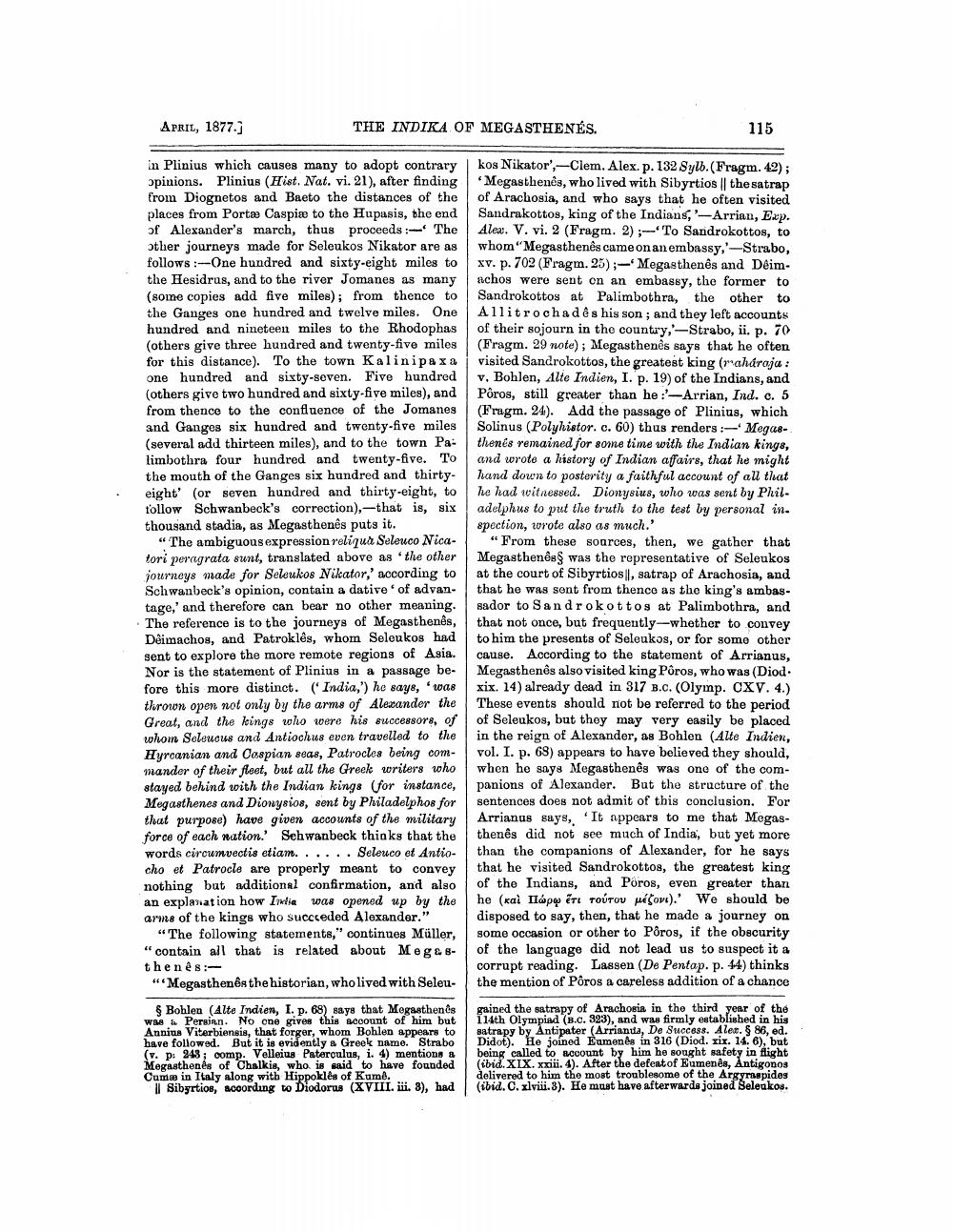________________
THE INDIKA OF MEGASTHENES.
APRIL, 1877.]
in Plinius which causes many to adopt contrary opinions. Plinius (Hist. Nat. vi. 21), after finding from Diognetos and Baeto the distances of the places from Porta Caspia to the Hupasis, the end of Alexander's march, thus proceeds: The other journeys made for Seleukos Nikator are as follows:-One hundred and sixty-eight miles to the Hesidrus, and to the river Jomanes as many (some copies add five miles); from thence to the Ganges one hundred and twelve miles. One hundred and nineteen miles to the Rhodophas (others give three hundred and twenty-five miles for this distance). To the town Kalinipa xa one hundred and sixty-seven. Five hundred (others give two hundred and sixty-five miles), and from thence to the confluence of the Jomanes and Ganges six hundred and twenty-five miles (several add thirteen miles), and to the town Palimbothra four hundred and twenty-five. To the mouth of the Ganges six hundred and thirtyeight' (or seven hundred and thirty-eight, to follow Schwanbeck's correction), that is, six thousand stadia, as Megasthenês puts it.
"
"The ambiguous expression reliqua Seleuco Nicatori peragrata sunt, translated above as 'the other journeys made for Seleukos Nikator,' according to Schwanbeck's opinion, contain a dative of advantage,' and therefore can bear no other meaning. The reference is to the journeys of Megasthenês, Dêimachos, and Patroklês, whom Seleukos had sent to explore the more remote regions of Asia. Nor is the statement of Plinius in a passage before this more distinct. (India,') he says, was thrown open not only by the arms of Alexander the Great, and the kings who were his successors, of whom Seleucus and Antiochus even travelled to the Hyrcanian and Caspian seas, Patrocles being commander of their fleet, but all the Greek writers who stayed behind with the Indian kings (for instance, Megasthenes and Dionysios, sent by Philadelphos for that purpose) have given accounts of the military force of each nation.' Schwanbeck thinks that the words circumvectis etiam...... Seleuco et Antiocho et Patrocle are properly meant to convey nothing but additional confirmation, and also an explanation how India was opened up by the arms of the kings who succeeded Alexander."
"The following statements," continues Müller, "contain all that is related about Megasthenês:"Megasthenes the historian, who lived with Seleu
§ Bohlen (Alte Indien, I. p. 68) says that Megasthenês was a Persian. No one gives this account of him but Annius Viterbiensis, that forger, whom Bohlen appears to have followed. But it is evidently a Greek name. Strabo (v. p. 243; comp. Velleius Paterculus, i. 4) mentions a Megasthenes of Chalkis, who is said to have founded Cuma in Italy along with Hippoklês of Kumê.
Il Sibyrtios, according to Diodorus (XVIII. iii. 8), had
115
kos Nikator',-Clem. Alex. p. 132 Sylb. (Fragm. 42); 'Megasthenes, who lived with Sibyrtios || the satrap of Arachosia, and who says that he often visited Sandrakottos, king of the Indians,'-Arrian, Exp. Alex. V. vi. 2 (Fragm. 2);-To Sandrokottos, to whom "Megasthenês came on an embassy,'-Strabo, xv. p. 702 (Fragm. 25);- Megasthenês and Dêimachos were sent on an embassy, the former to Sandrokottos at Palimbothra, the other to Allitrocha dês his son; and they left accounts of their sojourn in the country,'-Strabo, ii. p. 70 (Fragm. 29 note); Megasthenês says that he often visited Sandrokottos, the greatest king (raharaja : v. Bohlen, Alte Indien, I. p. 19) of the Indians, and Pôros, still greater than he:'-Arrian, Ind. c. 5 (Fragm. 24). Add the passage of Plinius, which Solinus (Polyhistor. c. 60) thus renders:- Megasthenés remained for some time with the Indian kings, and wrote a history of Indian affairs, that he might hand down to posterity a faithful account of all that he had witnessed. Dionysius, who was sent by Philadelphus to put the truth to the test by personal inspection, wrote also as much.'
"From these sources, then, we gather that Megasthenes§ was the representative of Seleukos at the court of Sibyrtios, satrap of Arachosia, and that he was sent from thence as the king's ambassador to Sandrokottos at Palimbothra, and that not once, but frequently-whether to convey to him the presents of Seleukos, or for some other cause. According to the statement of Arrianus, Megasthenês also visited king Pôros, who was (Diod. xix. 14) already dead in 317 B.C. (Olymp. CXV. 4.) These events should not be referred to the period of Seleukos, but they may very easily be placed in the reign of Alexander, as Bohlen (Alte Indien, vol. I. p. 68) appears to have believed they should, when he says Megasthenês was one of the companions of Alexander. But the structure of the sentences does not admit of this conclusion. For Arrianus says, 'It appears to me that Megasthenês did not see much of India, but yet more than the companions of Alexander, for he says that he visited Sandrokottos, the greatest king of the Indians, and Poros, even greater than he (καὶ Πώρῳ ἔτι τούτου μέζονι).’We should be disposed to say, then, that he made a journey on some occasion or other to Pôros, if the obscurity of the language did not lead us to suspect it a corrupt reading. Lassen (De Pentap. p. 44) thinks the mention of Pôros a careless addition of a chance
gained the satrapy of Arachosia in the third year of the 114th Olympiad (B.c. 323), and was firmly established in his satrapy by Antipater (Arrianda, De Success. Alex. § 86, ed. Didot). He joined Eumenes in 316 (Diod. xix. 14. 6), but being called to account by him he sought safety in flight (ibid. XIX. xxiii. 4). After the defeat of Eumenês, Antigonos delivered to him the most troublesome of the Argyraspides (ibid. C. xlviii. 3). He must have afterwards joined Seleukos.




